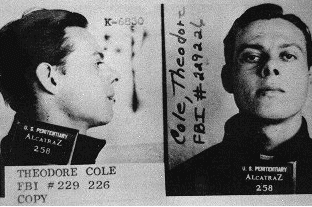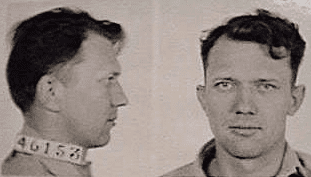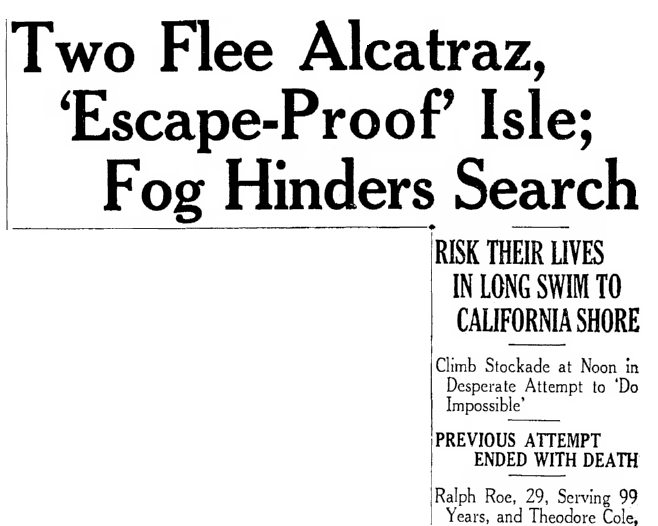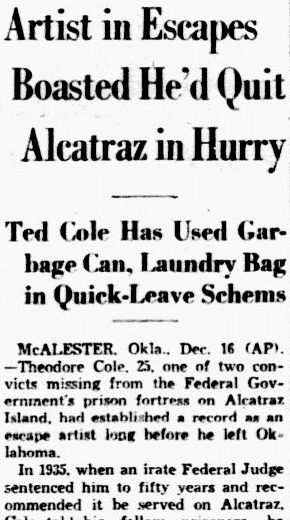They said it could not be done, and the official history of the island prison says it never was done: no one ever escaped from Alcatraz Island during the 29 years (1934-63) it was a federal penitentiary. It was not just the lookout towers, the armed guards with orders to shoot to kill, the high walls, iron bars, or steep cliffs that dropped straight into San Francisco Bay.
No, what made Alcatraz “escape-proof” was the bay itself: cold, choppy water with strong currents and rip-tides that made the 1.5-mile swim to the shore impossible. Such famous inmates as Al “Scarface” Capone and George “Machine Gun” Kelly certainly never tried.

On 16 December 1937, however, two lesser-known convicts may have done the impossible. Two bank robbers from Oklahoma, Theodore Cole and Ralph Roe, vanished from Alcatraz between 1:00 and 1:30 that afternoon. No trace was ever found of them. Had these two somehow defied the odds and made their way to freedom?

It was a cold, extremely foggy afternoon that 1937 day when Cole and Roe made their escape attempt. Pilots operating ferry boats on the bay said the water was very choppy, with a powerful ebb-tide rushing at 7-9 knots straight out the Golden Gate Bridge into the Pacific Ocean.
Cole and Roe both had a history of attempted prison escapes while incarcerated in Oklahoma, and Cole had boasted that Alcatraz could not hold him. The day they vanished, the two were working in a tire repair shop in the Alcatraz Prison yard when a guard made a headcount at 1:00. The guard then checked several other prison shops, and when he returned to the tire shop at 1:30 Cole and Roe were gone!
The men had cut through two iron bars and smashed through a glass window, and under the cover of the dense fog broke the lock on a gate and slipped through the outside fence. The wrench they stole from the tire shop to smash the lock was found, but they left behind no other sign. Just outside the fence was a 20-foot drop down into the cold, churning waters of the bay.
Did they make it? Prison officials insisted they could not possibly have made that arduous swim and most definitely drowned. While that is the likely scenario history will never know for sure, because their bodies were never recovered despite an exhaustive search by local and state officials, as well as the Coast Guard.
[Note: On 11 June 1962, three other convicts – Clarence and John Anglin, and Frank Morris – also made it off the island, but (like Theodore Cole and Ralph Roe) are officially presumed dead, drowned in San Francisco Bay. None of the five bodies was ever recovered, however.]
The following two newspaper articles reported on Cole and Roe’s escape. The first is an account of the escape itself and the resulting search, while the second describes their earlier attempts to break out of prison.

Here is a transcription of this article:
Two Flee Alcatraz, “Escape-Proof’ Isle; Fog Hinders Search
Risk Their Lives in Long Swim to California Shore
Climb Stockade at Noon in Desperate Attempt to ‘Do Impossible’
Previous Attempt Ended with Death
Ralph Roe, 29 [correction: 28], Serving 99 Years, and Theodore Cole, 23 [correction: 24], Serving 50 Years, Hunted by Coast Guard
San Francisco, Dec. 16 – (AP) – Two long-term convicts vanished today from supposedly escape-proof Alcatraz Island federal penitentiary, apparently staking their lives on an attempt to swim a mile and a quarter to shore through cold, fog-shrouded waters.
No prisoner ever has been known to escape from the dreary San Francisco Bay island by swimming, although trained distance swimmers, accompanied by boats, have crossed the rough, tide-swept channel in tests.
Believed off Island
Warden James A. Johnston, completing a search of the grounds at 6 p.m., said he believed the men were “off the island.”
Federal, state and city officers mobilized quickly to hunt for the pair, Ralph Roe, 29 [28], of Duncan, Okl., and Theodore Cole, 23 [24], of Stroud, Okl., on the theory they had reached the bay from the rocky prison site, but hours afterward no trace of them had been found.
The two were missing at the noon checkup, and officials expressed belief they had escaped over a stockade and climbed down to the shores of the 12-acre island, where the federal government keeps its worst convicts.
Various officials expressed doubt the pair could reach the mainland without the aid of boat or raft, but nevertheless a strong police patrol was posted along the San Francisco shore.
Fog Hinders Searchers
So dense was a low-lying fog that Coast Guard and police boats were seriously hampered in searching for the men, one serving 99 years for bank robbery, the other 50 years for kidnapping.
The police launch D. A. White halted its search at dark when visibility was reduced to less than 50 feet, but several Coast Guard craft continued to circle the island and cruise out toward the Golden Gate, where there was a strong ebb tide.
In Washington, Director of Federal Prisons James V. Bennett disclosed that the Coast Guard vessels were operating in accordance with previous plans worked out for just such an emergency.
Warden Johnston said he did not believe either of the men had been able to arrange outside aid to escape, and he said it was unlikely they had fled in a speedboat.
Within a short time after the men disappeared, and before they could have reached any shore, all Bay District law enforcement agencies were notified by teletype, permitting officers to establish a ring virtually around the area.
No Strange Boats Seen
The tide rushed past Alcatraz at seven miles an hour. Ferry line pilots said they had not observed any strange boats near the prison, nor had they sighted anyone swimming in the choppy waves.
The acting agent in charge of the Federal Bureau of Investigation here said he was informed that Roe and Cole had escaped over a stockade while heavy fog hid them from the constant watch of guards on high towers. One prisoner once attempted to escape in such a manner but was shot dead by a guard.
Al (“Scarface”) Capone, former Chicago gang leader convicted of income tax evasion, is among the 280-odd prisoners on the island.
Alcatraz, a former army barracks and once a Spanish prison, became a federal penitentiary in August, 1934, after Atty-Gen. Homer S. Cummings decided to house incorrigible prisoners there.
The most modern methods of thwarting escaped were installed, and two outbreaks later were quelled without anyone fleeing from “the rock,” as prisoners term the island.
Warden Recently Hurt
Warden Johnston recovered only recently from head injuries inflicted when a disgruntled convict attacked him in the prison dining room. Last September 24, Burton Phillips, kidnapper and bank robber from Wichita, Kan., beat Warden Johnston severely before being subdued.
Warden Johnston at the time had questioned some 100 convicts who had staged a “strike.”
The first uprising on the rocky island took place in January, 1936, when more than 100 prisoners rioted because of stringent rules.
Guards quickly put the ringleaders in dungeons and others, after bread and water diets, finally returned to their jobs in prison establishments.
To Continue Search
Although the search became difficult when darkness fell over the island, Director Bennett said posses of guards would continue their search into every nook and cranny of the island.
While small groups of armed guards searched the rocky cliffs, searchlights played up and down the slopes.
Bennett disclosed that Coast Guard vessels were operating in accordance with previous plans drawn up in preparation for just such an emergency. Using a carefully worked-out code, the vessels maintained constant contact with Warden Johnston. It was understood they would stop and search any small craft of suspicious character throughout the night.

Here is a transcription of this article:
Artist in Escapes Boasted He’d Quit Alcatraz in Hurry
Ted Cole Has Used Garbage Can, Laundry Bag in Quick-Leave Schemes
McALESTER, Okla., Dec. 16 (AP) – Theodore Cole, 25 [24], one of two convicts missing from the Federal Government’s prison fortress on Alcatraz Island, had established a record as an escape artist long before he left Oklahoma.
In 1935, when an irate Federal Judge sentenced him to fifty years and recommended it be served on Alcatraz, Cole told his fellow prisoners he didn’t think he would like the island and doubted he would stay there long enough to be bored.
Ralph Roe, another Oklahoman missing with Cole, also was hard to keep behind the bars but he was no match for his companion.
In 1929, when he was only 17 [16], Cole heard the death sentence pronounced by a Tulsa County District Judge after he had pleaded guilty to a $400 bottling plant robbery. The sentence raised a storm of protest. In 1930 the sentence was reduced to fifteen years.
Three years later, he made his first attempt at a prison break. He slipped across the yard at McAlester penitentiary and attempted to mount a wall. A guard shot him down.
In March, 1934, Cole allegedly stabbed his cellmate, William Pritchett, to death. He was charged with murder. On Dec. 1 a laundry truck pulled out of the prison yard. In one laundry bag was Cole.
When the truck was well outside the yards, Cole cut open the sack, threatened two trusties with death and escaped.
A short time later he turned up at Cushing, kidnapped J. A. Rutherford, a pipe line worker, and forced him to drive to Illinois. With officers hot on his trail, he doubled back into Texas. On Dec. 5 he was trapped in a Dallas hotel and overpowered.
Hid in Garbage Can
Returned to the county jail in Oklahoma City Cole began to give his jailers headaches.
“He gave us more trouble than all the other prisoners we ever had,” Sheriff Stanley Rogers recalled.
In April, 1935, Cole hid in a garbage can. Ordinarily jail trusties took the garbage outside but on this particular morning E. E. Herron, the jailer, ordered them to set the can down in the front office. Several minutes later Herron was astonished to see the lid on the can rise and Cole step out.
The slippery convict was placed under heavy guard. He was heavily shackled but he shed leg and wrist irons with no apparent difficulty and it became his standing joke to have the irons laid neatly beside the door of his cell each morning.
But while he was having his daily joke, Cole was doing a little serious work. Somehow, he removed his cell bars but when freedom was close he was discovered. His cell was wired with a loud-speaking device which amplified his every move.
In May, 1935, he was taken to Guthrie and Federal Judge Edgar S. Vaught sentenced him to fifty years at Alcatraz for the Cushing kidnapping.
Pal of Wilbur Underhill
Several months later he was removed to the island fortress on the same train that carried Ralph Roe.
Roe had a long prison record. His first escape attempt was made in 1929 when he was a prisoner at McAlester. He had himself nailed in a box and shipped from the penitentiary but he was hardly 300 yards outside the walls when the close air inside the box made him reveal his hiding place. Prison guards recaptured him without difficulty.
After completing his term Roe became associated with Wilbur Underhill, one of Oklahoma’s most notorious killers, and with Underhill he was charged with robbery of the First National Bank of Harrah five years ago.
On Dec. 30, 1933, Underhill was cornered by officers in Shawnee and shot to death. Roe was wounded and captured.
Roe finally was brought to trial on a charge of robbing the Farmers National Bank at Sulphur. For that offense he was sentenced to Alcatraz.
Note: An online collection of newspapers, such as GenealogyBank’s Historical Newspaper Archives, is not only a great way to learn about the lives of your ancestors – the old newspaper articles also help you understand American history and the times your ancestors lived in, and the news they talked about and read in their local papers.

Alcatraz did john/clarence anglin with frank morris escape the Rock?if hear Hopkin he give credit other people on Rock in utube and in book?charlie E Hopkins #1186 alcatraz as kid stole _anything eventually land in trouble many times end up in the _ &met many people from these institutions?He grew he claim
his mom Dessie,dad was Ridgeways of Tennessee?charlie claim bro carl,mule,elmo?
charlie E Hopkins mom bessie 14(not DESSIE) his step father John Hopkins40
children:1/taylor 2/charles 3/twins 4/bradley 5/ margaret 6/twins?
up mom bessie 14(not DESSIE) his step father Ashley J Finerty40.
children:1/ashley 2/walter P 3/Alice 4/janie 5/andrew (jimmy) etc. btw charlie hopkins claim met clarence anglin in mariana industrial school for boys& charlie Hopkins got pen 1963 so he was around anglins/frank morris in Alcatraz to spread stories ?in _ woman claim clarence Anglin(j.w.anglin ) another man were live on farm working near 2Egg florida but when got there claim the men were gone the reporter had no story or b~s?